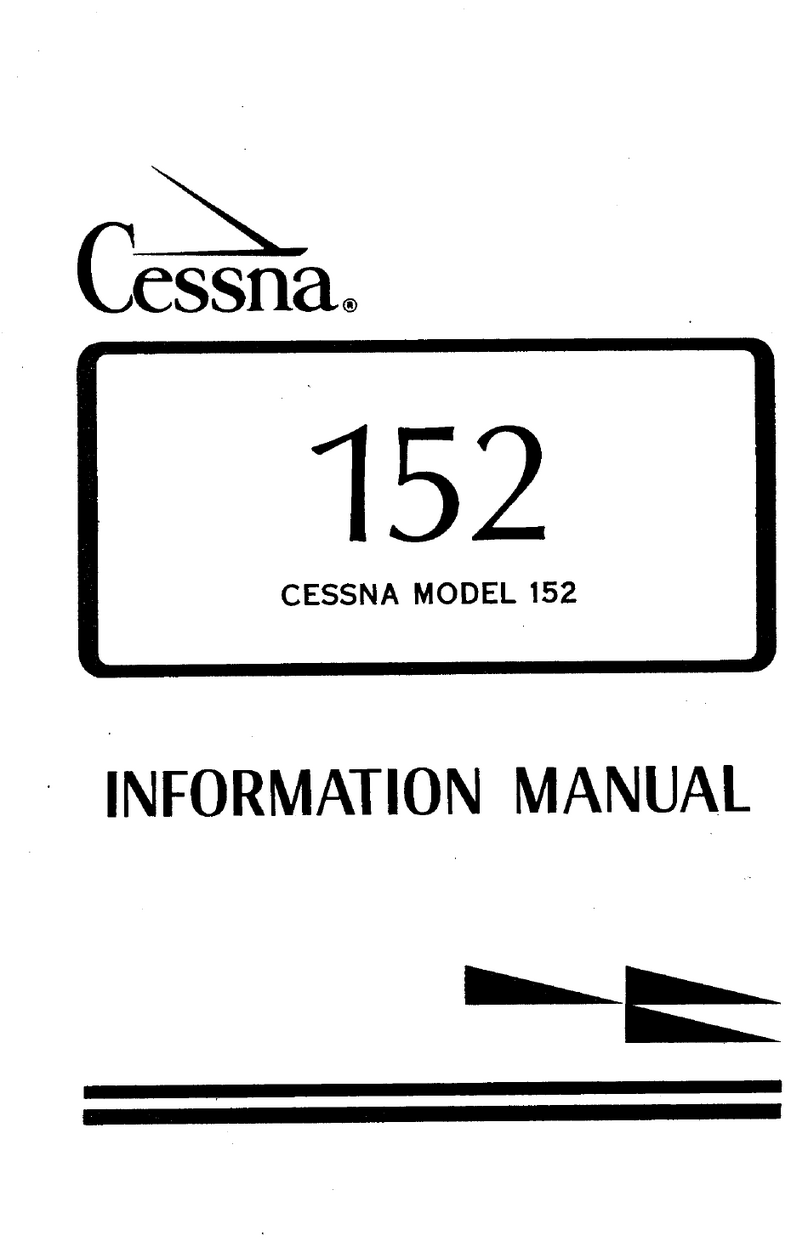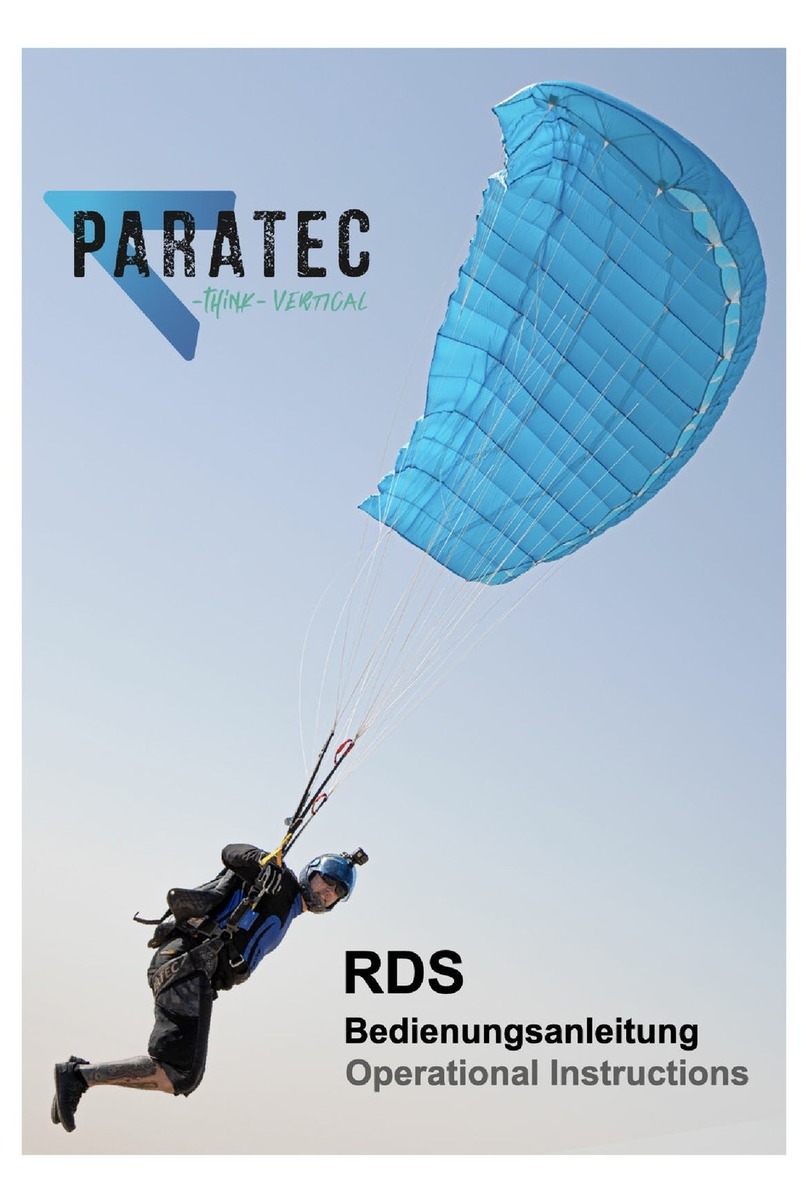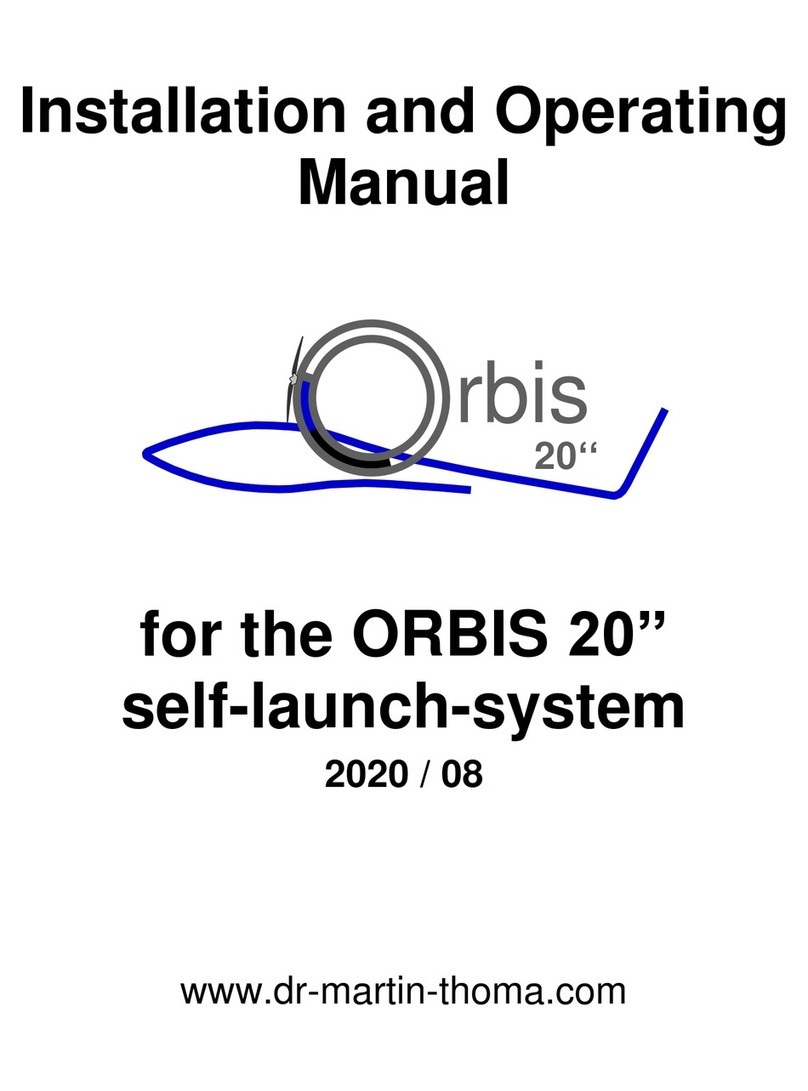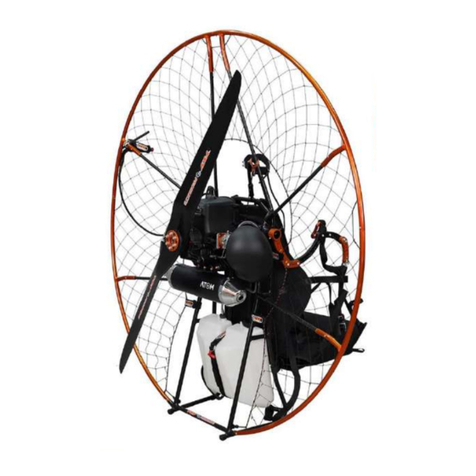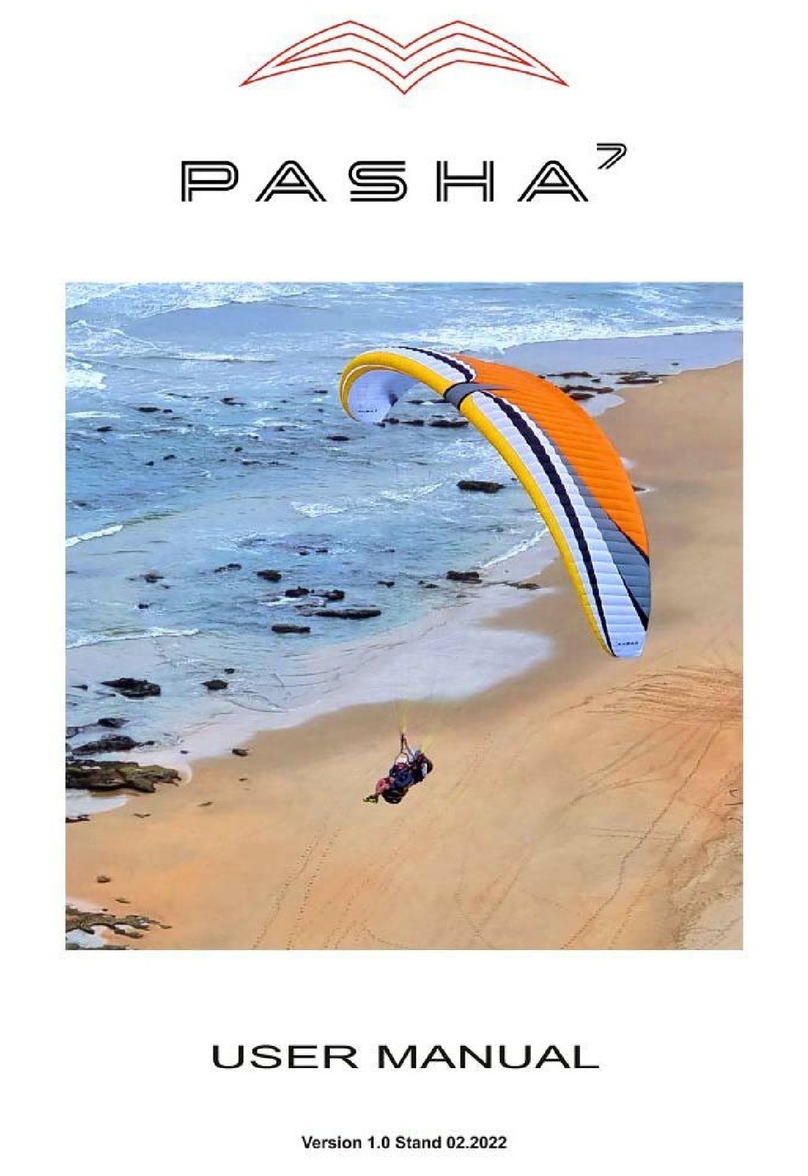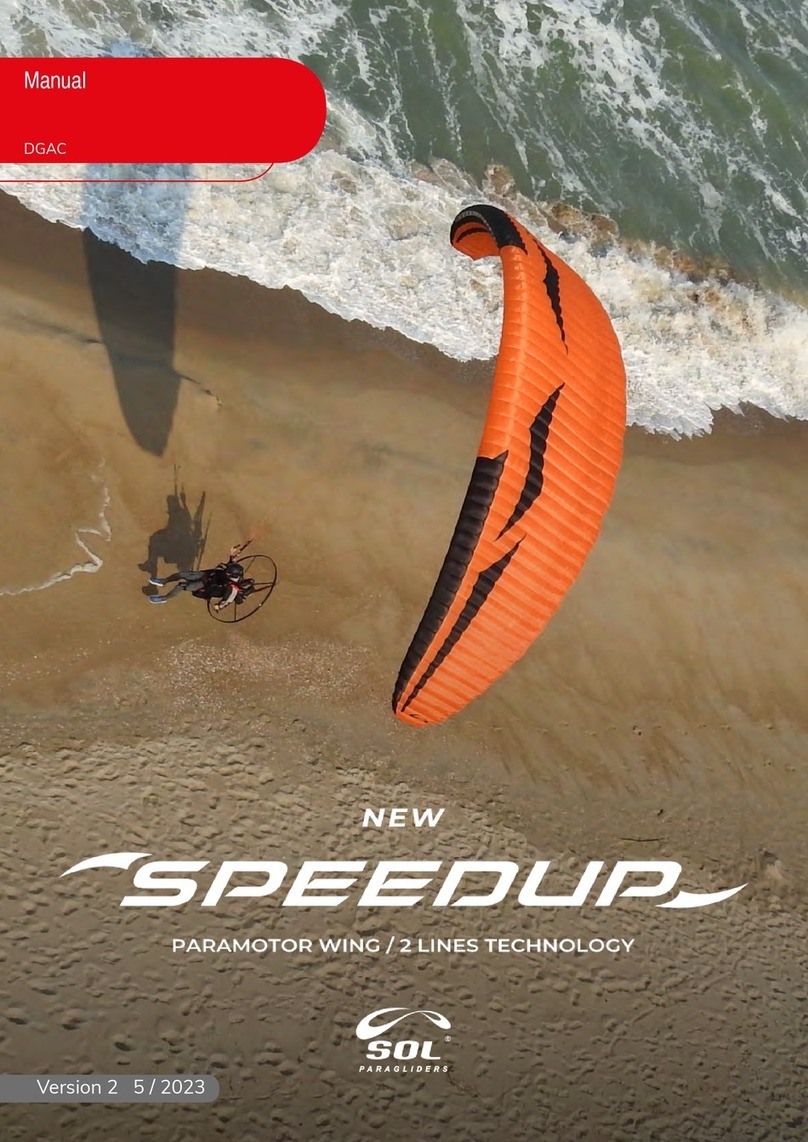Direct Fly ALTO 912 TG Owner's manual

The Direct Fly
Alto 912 TG
PILOT´S OPERATING HANDBOOK
DFE-POH-AR1

PILOT´S OPERATING HANDBOOK
DFE-POH-AR1 Rev. 2
Aircraft model /
modification
:
ALTO
Manufacturer : Direct Fly s r.o.
Airplane Serial Number:
Airplane Registration Number:
Issued on : February 27, 2015
Revision : 2
This aircraft must be operated following the instruction and
limitation stated in this flight manual.
This flight manual must be kept within reach of pilot during
flight.
DF051
PU-RJR
912 TG

PILOT´S OPERATING HANDBOOK
DFE-POH-AR1 Rev. 2
RECORD OF MANUAL REVISIONS
This manual is revised as a complete document. All pages must display the same revision number.
Revision Notes:
Revision
Issue Date
Description
0 Oct 26, 2010 Initial Issue
1 Jul 20, 2014
Layout revised per ASTM F2746-12.
Publication number is now using the Direct Fly / Erres Industria Aeronautica
patern.
Revised to comply with the Brazilian version of the Alto 912 TG.
Revised List of Supplements.
2 Feb 27, 2015 Revised list of ASTM Consensus Standards

PILOT´S OPERATING HANDBOOK
DFE-POH-AR1 Rev. 2
TABLE OF CONTENTS
INTRODUCTION
ASTM Standards ……….…………………………………......…………..........................………….…..……. i
Contact Information ………………………………………………….……………..........................…………... i
Data Location …………………………………………………………………………..........................……….. ii
Section 1— GENERAL INFORMATION....................................................................................................... 1-0
1.1 Introduction to the Alto TG 912................................................................................................ 1-0
1.1.1 Side, Top and Front Views...................................................................................................... 1-0
1.2 Performance Specifications..................................................................................................... 1-1
1.2.1 Maximum Gross Weight........................................................................................................... 1-1
1.2.2 Aircraft Speed and Power Settings.......................................................................................... 1-1
1.2.3 Aircraft Range and Endurance …………… ........................……………………………………...1-1
1.2.4 Rate of climb............................................................................................................................ 1-2
1.2.5 Stall Speed............................................................................................................................... 1-2
1.2.6 Total Fuel Capacity.................................................................................................................. 1-2
1.2.7 Max. Engine Power.................................................................................................................. 1-2
Section 2 —LIMITATIONS............................................................................................................................ 2-0
2.1 Airspeed Indicator Markings.................................................................................................... 2-0
2.2 Airspeed Limitations................................................................................................................. 2-0
2.3 Service Ceiling......................................................................................................................... 2-0
2.4 Load Factors............................................................................................................................ 2-0
2.5 Approved Maneuvers............................................................................................................... 2-1
2.6 Total Fuel, Approved Fuel ....................................................................................................... 2-1
2.6.1 Fuel Capacity........................................................................................................................... 2-1
2.6.2 Approved Fuel Grades............................................................................................................. 2-1
2.7 Max Engine Power Output @ stated RPM .............................................................................. 2-1
2.8 Applicable Environmental Limitations...................................................................................... 2-1
2.9 Applicable VFR night or IFR limitations................................................................................... 2-1
Section 3 — EMERGENCY PROCEDURES ............................................................................................... 3-0
3.1 General Information................................................................................................................. 3-0
3.2 Airspeeds for Emergency Procedures..................................................................................... 3-0
3.3 Emergency Checklist............................................................................................................... 3-0
3.3.1 Engine Fire During Start .......................................................................................................... 3-0
3.3.2 Engine Failure During Takeoff................................................................................................. 3-0
3.3.3 Loss of Engine Power In Flight................................................................................................ 3-0
3.3.4 Engine Failure and Emergency Landing.................................................................................. 3-1
3.3.5 Precautionary Landing with engine power............................................................................... 3-1
3.3.6 Fire in flight .............................................................................................................................. 3-1
3.3.7 Loss of oil pressure.................................................................................................................. 3-1
3.3.8 High oil pressure...................................................................................................................... 3-1
3.3.9 Emergency descent................................................................................................................. 3-2
3.3.10 Alternator failure....................................................................................................................... 3-2
3.3.11 Overvoltage.............................................................................................................................. 3-2
3.3.12 Inadvertent spin ....................................................................................................................... 3-2
3.3.13 Inadvertent icing encounter ..................................................................................................... 3-2
3.3.14 Loss of Primary Instruments.................................................................................................... 3-2
3.3.15 Loss of Flight Controls............................................................................................................. 3-3
3.3.16 In-flight Engine Starting............................................................................................................ 3-3
Section 4 — NORMAL PROCEDURES ....................................................................................................... 4-0
4.1 Preflight Check List ................................................................................................................. 4-0
4.1.1 Cockpit..................................................................................................................................... 4-0
4.1.2 Power Unit ............................................................................................................................... 4-0
4.1.3 Undercarriage .......................................................................................................................... 4-0

PILOT´S OPERATING HANDBOOK
DFE-POH-AR1 Rev. 2
4.1.4 Right Wing ............................................................................................................................... 4-0
4.1.5 Empennage and Fuselage....................................................................................................... 4-0
4.1.6 Left Wing.................................................................................................................................. 4-1
4.1.7 Undercarriage .......................................................................................................................... 4-1
4.2 Engine starting......................................................................................................................... 4-1
4.2.1 Engine warm up and Test........................................................................................................ 4-1
4.3 Taxiing ..................................................................................................................................... 4-2
4.4 Normal Takeoff ........................................................................................................................ 4-2
4.5 Climb........................................................................................................................................ 4-2
4.5.1 Best angle of climb speed (Vx)................................................................................................ 4-2
4.5.2 Best rate of climb speed (Vy)................................................................................................... 4-2
4.6 Cruise....................................................................................................................................... 4-2
4.7 Approach.................................................................................................................................. 4-3
4.7.1 Descent.................................................................................................................................... 4-3
4.7.2 Approaching the airport............................................................................................................ 4-3
4.8 Normal landing......................................................................................................................... 4-3
4.8.1 Downwind ................................................................................................................................ 4-3
4.8.2 Base Leg.................................................................................................................................. 4-3
4.8.3 Final approach ......................................................................................................................... 4-3
4.8.4 Landing .................................................................................................................................... 4-3
4.8.5 After Landing............................................................................................................................ 4-3
4.8.6 Engine Cooling and Stop......................................................................................................... 4-4
4.8.7 Check After Flight .................................................................................................................... 4-4
4.9 Short Field Takeoff and Landing Procedures.......................................................................... 4-4
4.9.1 Short Field Takeoff................................................................................................................... 4-4
4.9.2 Short Field Landing..................................................................................................................... 4-4
4.10 Soft Field Takeoff and Landing Procedures ............................................................................ 4-4
4.10.1 Soft Field Takeoff..................................................................................................................... 4-4
4.10.2 Soft Field Landing.................................................................................................................... 4-4
4.11 Balked Landing procedures..................................................................................................... 4-4
Section 5 — PERFORMANCE...................................................................................................................... 5-0
5.1 Takeoff over a 50’obstacle ...................................................................................................... 5-0
5.2 Landing over a 50’ obstacle .................................................................................................... 5-0
5.3 Rate of Climb........................................................................................................................... 5-0
5.4 Cruise speed .......................................................................................................................... 5-0
5.5 RPM settings and fuel consumption........................................................................................ 5-1
5.6 Airspeed System Calibration ................................................................................................... 5-1
5.7 Stall speed .............................................................................................................................. 5-1
Section 6 — WEIGHT AND BALANCE AND EQUIPMENT LIST ............................................................... 6-0
6.1 Weight and Balance Chart....................................................................................................... 6-0
6.2 Operating weights and load..................................................................................................... 6-1
6.3 CG range and determination ................................................................................................... 6-2
6.4 Installed optional equipment list............................................................................................... 6-3
Section 7 — DESCRIPTION OF AIRPLANE AND SYSTEMS .................................................................... 7-0
7.1 General ................................................................................................................................... 7-0
7.2 Airframe ................................................................................................................................... 7-0
7.2.1 Wings ......................................................................................................................................7-1
7.2.2 Fuselage .................................................................................................................................7-1
7.2.3 Tail Unit ...................................................................................................................................7-1
7.2.4 Landing Gear ..........................................................................................................................7-1
7.2.5 Cockpit ....................................................................................................................................7-1
7.3 Flight Controls..........................................................................................................................7-1
7.3.1 Longitudinal Control ................................................................................................................7-1
7.3.2 Lateral Control ........................................................................................................................7-1
7.3.3 Rudder Control .......................................................................................................................7-1
7.3.4 Elevator Trim Tab Control........................................................................................................ 7-1
7.3.5 Aileron Trim Tab Control......................................................................................................... .7-2
7.4 Instrument Panel...................................................................................................................... 7-2

PILOT´S OPERATING HANDBOOK
DFE-POH-AR1 Rev. 2
7.5 Flight instruments .................................................................................................................... 7-3
7.6 Engine ..................................................................................................................................... 7-5
7.7 Propeller .................................................................................................................................. 7-5
Section 8 —HANDLING AND SERVICING ................................................................................................. 8-0
8.1 Introduction ............................................................................................................................. 8-0
8.2 Ground handling ..................................................................................................................... 8-0
8.3 Towing ..................................................................................................................................... 8-0
8.4 Tie-Down.................................................................................................................................. 8-0
8.5 Servicing ................................................................................................................................. 8-1
8.5.1 Fueling ..................................................................................................................................... 8-1
8.5.1.1 Approved fuel grades and specifications................................................................................. 8-2
8.5.2 Oil Filling .................................................................................................................................. 8-2
8.5.2.1 Approved oil grades and specifications................................................................................... 8-3
8.5.3 Coolant..................................................................................................................................... 8-3
8.5.3.1 Recommended Types of Coolant ............................................................................................ 8-3
8.5.4 Brake Fluid .............................................................................................................................. 8-4
8.5.4.1 Recommended Type of Brake Fluid ....................................................................................... 8-4
8.6 Cleaning and Care................................................................................................................... 8-5
Section 9 — SUPPLEMENTS ...................................................................................................................... 9-0
9.1 Aditional Information regarding the Airplane............................................................................ 9-0
9.1.1 Tire inflation pressure ............................................................................................................. 9-0
9.1.2 Placards .................................................................................................................................. 9-0
9.2 Operation of Optional Equipments or Accessories ................................................................. 9-2
9.2.1 List of Supplements ................................................................................................................ 9-2
9.3 Airplane Flight Training Supplement (FTS) ............................................................................ 9-3
9.4 Information the owner can use for:.......................................................................................... 9-3
9.4.1 Improvements or Corrections .................................................................................................. 9-3
9.4.2 Continued Operational Safety Reporting................................................................................. 9-4
9.4.3 Owner Change of Adress Notice ............................................................................................ 9-5

PILOT´S OPERATING HANDBOOK
DFE-POH-AR1 Rev. 2 i
INTRODUCTION
ASTM Standards
List of the ASTM standards used for the design, construction, continued airworthiness, and compliance
with this standard.
Designation: F 2245 – 12b
Design and Performance of a Light Sport Airplane
Designation: F 2972 - 12
Standard Specification for Light Sport Aircraft Manufacturer’s Quality Assurance System
Designation: F 2295 – 06
Standard Practice for Continued Operational / Safety Monitoring of a Light Sport Aircraft
Designation: F 2483 – 12
Standard Practice for Maintenance and the Development of Maintenance Manuals for Light Sport
Aircraft
Designation: F 2626 – 12
Standard Terminology for Light Sport Aircraft
Designation: F2746-12
Pilot’s Operation Handbook (POH)
Designation: ASTM F2506-10
Standard Specification for Design and Testing of Light Sport Aircraft Propellers
Designation: ASTM F2339-06
Standard Practice for Design and Manufacture of Reciprocating Spark Ignition Engines for Light Sport
Aircraft
Contact Information
Company headquarter:
Direct Fly s.r. o.
Špitálka 8
602 00 Brno,
Czech Republic
www.directfly.cz
The Manufacturing Facility:
Direct Fly s.r.o.
Cihelní 573
687 25 Hluk
Czech Republic
The Brazilian Dealer:
Erres Industria Aeronautica Ltda.
Rua Baden Powel, 43 - Bairro São José
Santa Maria – RS – 79110-120

PILOT´S OPERATING HANDBOOK
DFE-POH-AR1 Rev. 2 ii
www.erresaeronautica.com.br
contato@erresaeronautica.com.br
Data Location
Company headquarter:
Direct Fly s.r. o.
Špitálka 8
602 00 Brno,
Czech Republic

PILOT´S OPERATING HANDBOOK
DFE-POH-AR1 Rev. 2 1-0
Section 1 – GENERAL INFORMATION
1.1 Introduction to the Alto
Direct Fly ALTO 912 TG is an all-metal low wing aircraft with a riveted aluminum structure. Some non-
load bearing parts such as the engine cowling, wing tips, empennage tips, and wheel covers are made of
composite materials. The Alto is powered by the ROTAX 912 ULS engine (100 hp) and Woodcomp Propuls
three-blade ground-adjustable propeller. The two seats are arranged in a side-by-side configuration. The
tricycle landing gear features a steerable nose wheel and hydraulic brakes on main wheels.
Wing span ...................................................................................................... 8.20 m (26ft 11 in)
Length ............................................................................................................ 6.14 m (20ft 2 in)
Height............................................................................................................. 2.26 m (7ft 5 in )
Wing Area....................................................................................................... 10.52 m² (114 sq ft)
Mean aerodynamic chord (MAC)................................................................... 1,31 m (51.77 in)
Maximum take-off weight ............................................................................... 600 kg (1,320 lb)
1.1.1 Side, Top, and Front Views.
Fig 1-1: Side, Top, and Front Views

PILOT´S OPERATING HANDBOOK
DFE-POH-AR1 Rev. 2 1-1
1.2 Performance Specifications
AIRSPEEDS FOR NORMAL OPERATION
Takeoff: .............................................................. ....45 KIAS
Climb:
Normal: .............................................................. ....65 KIAS
Best Rate of Climb (Vy): .................................... ....60 KIAS
Best Angle of Climb (Vx): .................................. ....50 KIAS
Design Cruise Speed (Vc): ............................... ...... 110 KIAS
Landing Approach:
Flaps 0º: ............................................................. .....70 KIAS
Flaps 15º Position 1: .......................................... .....60 KIAS
Flaps 25º Position 2: .......................................... .....55 KIAS
Flaps 45º Position 3: .......................................... .....50 KIAS
Balked Landing: …………………………………........ 65 KIAS
Maximum Horizontal Flight Speed (V
h
): …………….120 KIAS
Maximum Structural Cruising Speed (V
No
): ……… ..110 KIAS
Maximum Demonstrated Crosswind Velocity: ... .....12 Knots
Maximum (Never Exceed Speed'(V
NE
): ………….…131 Knots
1.2.1 Maximum Gross Weight....................................... 600 kg (1320 lbs)
1.2.2 Aircraft Speeds and Power Settings (at 3,000‘ MSL)
Engine RPM
4,200
rpm
4,500
rpm 4,800 rpm 5,000 rpm 5,200 rpm 5,500 rpm
IAS, kts 73.0 88.0 99.0 107.0 114.0 118.0
CAS, kts 72.0 85.0 95.0 104.0 111.0 115.0
TAS, kts
73.0 86.0 97.0 106.0 112.0 117.0
1.2.3 Aircraft Range and Endurance.
The following table lists fuel consumption, endurance and range at 3,000‘ MSL. Endurance and range are
with 45 minutes of fuel reserves remaining.
Engine RPM
4,200 rpm 4,500 rpm 4,800 rpm 5,000 rpm 5,200 rpm 5,500 rpm
Fuel consumption,
gallons per hour 3.0 3.7 4.5 4.9 5.3 6.1
Fuel consumption,
liters per hour 11.3 14.0 17.0 18.5 20.0 23.1
Endurance, hours 7.0 5.6 4.6 4.2 4.0 3.4
Range, miles
511 488 452 454 443 402

PILOT´S OPERATING HANDBOOK
DFE-POH-AR1 Rev. 2 1-2
1.2.4 Rate of climb
Vx – Best Angle of Climb
Altitude Rotax 912 ULS
Airspeed to achieve best angle
of climb
(KIAS)
Sea Level 15.8 fps 50
948 fpm
Vy –Best Rate of Climb
A
ltitude
R
otax
912 ULS
Airspeed to achieve best rate of climb (
KIAS
)
Sea Level 17 fps 60
1020 fpm
3,000 ft 14 fps 60
850 fpm
1.2.5 Stall speed: Vs
1
and Vs
0
Vs
1
............................................... .................... 41 kts
Vs
0
................................................................ 35 kts
Stall speed table is valid for weight of for 1320 lb (600 kg) and level flight.
Degrees
Indicator
Stall speed (KIAS)
Flaps up
0º 41
Flaps
–
take
-
off
15º I 39
Flaps
–
landing
25º II 37
Flaps
–
landing
45º III 35
1.2.6 Total fuel capacity, total usable fuel and approved types of fuel
Usable fuel – each wing tank......................... 46.0 l (12.1 gal)
Usable fuel – total both tanks ....................... 92.0 l (24.2 gal)
Unusable fuel – total both tanks ....................... 11.4 l (3.0 gal)
Automotive fuel Natural 95 – unleaded fuel (standard fuel for automotive, ASTM D 4814) or AVGAS 100
LL.
1.2.7 Maximum engine power output at stated RPM
100 hp @ 5800 rpm ........................................... take off
94 hp @ 5500 rpm ............................................. continuous

PILOT´S OPERATING HANDBOOK
DFE-POH-AR1 Rev. 2 2-0
Section 2 — LIMITATIONS
2.1 Airspeed Indicators Marking
Marking
IAS, Kts
Meaning
White Arc 35 – 70 Operating range with extended flaps. Lower limit – Vs
0
at maximum
weight (flaps 45°) Upper limit – V
FE
Green Arc 41 – 110 Normal operation range Lower limit – V
s1
at maximum weight (flaps 0°)
Yellow Arc 110 – 131 Maneuvers must conducted with caution and only in smooth air
Red Line 131 Maximum speed for all operations – V
NE
2.2 Airspeed Limitations
Airspeed
IAS, kts
V
S1
Stalling speeds at maximum takeoff weight. (flaps 0°)41
V
S0
Stalling speeds at maximum takeoff weight. (flaps in landing position 45°) 35
V
FE
Highest permissible speed for wing flap extension. 70
V
NE
Never exceed this speed in any operation. 131
V
NO
Maximum structural cruise speed. 110
V
A
Maximum maneuvering speed. 89
V
B
Maximum gust intensity speed 90
Vo Operating maneuvering speed at gross weight 600 kg 86
Vo Operating maneuvering speed at minimum weight 350 kg 70
Do not make full or abrupt control movement above maneuvering speed
—
aircraft might be
overloaded.
2.3 Service Ceiling
(Rotax 912 ULS) ................................................................. 14,500 ft
2.4 Load Factors
Flaps Up
Maximum positive load factor..............................................+4
Maximum negative load factor.............................................-2
Flaps Down
Maximum positive load factor..............................................+2
Maximum negative load factor.............................................. 0

PILOT´S OPERATING HANDBOOK
DFE-POH-AR1 Rev. 2 2-1
2.5 Approved Maneuvers
•Steep turns up to bank angle of 60°
•Climbing turns
•Lazy eights
•Stalls (except for steep stalls)
•Normal flight maneuvers
•Entry speed into maneuvers 89 kts.
2.6 Total Fuel Capacity, Approved Fuel Grades
2.6.1 Fuel Capacity
Usable fuel – each wing tank......................... 46.0 l (12.1 gal)
Usable fuel – total both tanks ....................... 92.0 l (24.2 gal)
Unusable fuel – total both tanks ....................... 11.4 l (3.0 gal)
2.6.2 Approved Fuel Grades
•Min. RON 95, EN 228 Premium, EN 228 Premium plus or AVGAS100LL
•Fuel according to FAA - Standard Spec. for Automotive Spark-Ignition Engine Fuel,
ASTM D 4814 or AVGAS 100 LL.
•Fuel according to DOT - CAN/CGSB-3.5 Quality 3 min AKI 91 or AVGAS 100 LL.
Refer to the ROTAX engine Operator’s Manual-section 2.4
2.7 Max Engine Power Output @ stated RPM
Maximum take-off power .............................................. 100 hp (73.5 kW)
Maximum continuous power ........................................... 94 hp (69.0 kW)
Maximum (5 min) ............................................................5,800 rpm
Maximum for continuous operation.................................5,500 rpm
2.8 Applicable Environmental Limitations
Maximum demonstrated cross-wind component ............................. 12 knots
Maximum demonstrated wind (parallel to the runway) .................... 24 kts
Maximum tail wind (takeoff or landing) ........................................... 10 kts
Maximum outside temperature......................................................... 50 °C
Minimum outside temperature.........................................................-25 °C
2.9 Applicable VFR night or IFR limitations
The airplane is approved for:
•VFR daylight flights.
•VFR night flights are approved only when required lighting for such flights is installed and flight
performed by a pilot holding a current medical and appropriate ratings.
•IFR daylight and night flights are approved only when instrumentation and lighting required for such
flights by FAR Part 91 is installed and operational and the flight is performed by a pilot holding
current medical and appropriate ratings.
•The airplane is not authorized for flight into known or forecast possible icing conditions.
•The airplane is not authorized for flight within 25 miles of known lightning or thunderstorms.

PILOT´S OPERATING HANDBOOK
DFE-POH-AR1 Rev. 2 3-0
Section 3 — EMERGENCY PROCEDURES
3.1 General Information
This section covers the recommended procedures to follow during emergency and adverse flight
conditions. Emergency situation arising from engine failure are highly unlikely if pre-flight checks and
maintenance are properly performed according to the aircraft and engine manuals. Proper flight planning
and using good judgment can minimize or reduced emergencies caused by poor or unexpected weather
conditions.
As it is not possible to define every type of emergency that may occur, it is the pilot’s responsibility to
use sound judgment based on personal experience and knowledge of the aircraft to determine the best
course of action.
It is considered mandatory that the pilot be familiar with this entire manual, in particular, the
“Emergency Procedures” section prior to flight.
3.2 Airspeeds for Emergency Procedures
Optimum gliding speed - 67kts (9:1 glide ratio)
3.3 Emergency Checklist
3.3.1 Engine Fire During Start
Fuel valve.......................................................................... OFF
Throttle.............................................................................. FULL
Once engine stops:
Ignition............................................................................... OFF
Alternator........................................................................... OFF
Master switch .................................................................... OFF
Abandon aircraft and extinguish (if possible)
Damage to aircraft............................................................. evaluate
Do not operate aircraft until cause of fire has been identified and problem is solved.
3.3.2 Engine Failure during Take-Off
Airspeed............................................................................ adjust to 67 kts
Landing site selection
Below 150 ft................................................................ straight ahead, if possible
Above 150 ft................................................................ suitable place without obstacles, preferably in
the runway direction
Flaps.................................................................................. as needed
Fuel boost pump ............................................................... OFF
Fuel valve.......................................................................... OFF
Seat belts ......................................................................... Tighten
Master switch .................................................................... when landing assured OFF
3.3.3 Loss of Engine Power in Flight
Ignition ............................................................................BOTH ON
Fuel boost pump ............................................................... ON
Fuel valve.......................................................................... Fuel tank with higher quantity
If carburetor icing is suspected, apply carburetor heat (if available).
Look for possible landing area.

PILOT´S OPERATING HANDBOOK
DFE-POH-AR1 Rev. 2 3-1
3.3.4 Emergency Landing Without Engine Power
Airspeed............................................................................ 67 kts
Trim................................................................................... adjust
Landing site selection........................................................ select
Make sure the engine failure is not a consequence of unintentional switching off the ignition, or fuel
valve.
Try to restart the engine using 3.3.16 In-Flight Engine Starting, if altitude permits, otherwise proceed with
emergency landing using 3.3.2 Engine Failure during Take-Off.
3.3.5 Precautionary Landing with Engine Power
Select suitable location; evaluate wind speed/direction, surface, and obstacles. Fly past the selected
location at 67 kts and at a suitable altitude (150 ft recommended); evaluate the landing site.
Flaps.................................................................................. as needed
Land.
Once on the ground:
Brake................................................................................. as necessary
Ignition............................................................................... OFF
Master switch .................................................................... OFF
Fuel valve.......................................................................... OFF
3.3.6 Fire in Flight
Fuel valve.......................................................................... OFF
Throttle.............................................................................. full, if possible
Airspeed............................................................................ increase to extinguish fire — Do not exceed
V
ne
limitation
Land at nearest airfield or other suitable location.
Ignition............................................................................... OFF
Airspeed............................................................................ 67 kts
Flaps.................................................................................. as needed
Alternator switch................................................................ OFF
Seat belts .......................................................................... tighten
Master switch ............................................................ ...... When landing assured OFF
Perform emergency landing. Exit aircraft and if possible, extinguish fire.
Do not start the engine once fire has been extinguished.
Do not operate aircraft until the cause of the fire has been identified and the problem is
solved.
3.3.7 Loss of Oil Pressure
Engine failure typically occurs shortly after loss of oil pressure. Reduce throttle and land as soon
possible, consider off-field landing.
3.3.8 High Oil Pressure
Monitor oil pressure, (oil pressure is sense by electrical sending unit) land as soon as practical.

PILOT´S OPERATING HANDBOOK
DFE-POH-AR1 Rev. 2 3-2
3.3.9 Emergency descent
Power................................................................................ Idle
Optimum gliding speed ..................................................... 67 kts
Flaps.................................................................................. as needed
Best glide ratio (at 67 kts) ................................................. 1:9
3.3.10 Alternator Failure
Turn OFF all the non-essential equipment. You have approximately 30 minutes of battery, NOTE
time.
Land .................................................................................. as soon as practical
3.3.11 Overvoltage
Eletrical Equipment ........................................................... Turn all on - Monitor Voltage (If Volt Meter is
available)
Engine............................................................................... Reduce Power - Monitor Voltage (If Volt
Meter is available)
Land .................................................................................. as soon as practical
3.3.12 Inadvertent Spin
Characteristics of this aircraft during spin were not tested.
Use the following settings for spin recover.
Throttle.............................................................................. IDLE
Aileron............................................................................... NEUTRAL
Rudder............................................................................... against rotation
Control stick....................................................................... push
Once the rotation has stopped, center the rudder and establish level flight.
3.3.13 Inadvertent Icing Encounter
Throttle.............................................................................. increase above normal cruise
Heading............................................................................. leave icing area
Altitude .............................................................................. climb, if possible
Airspeed, recommended................................................... 90 kts
Airspeed, minimum ........................................................... 62 kts
Carb heat........................................................................... ON (If available).
In case of possible carburetor icing, pull on the carburetor heat (if available), immediately after icing clears,
push it back in again – as significant power is lost.
Land at the nearest airfield or proceed with emergency landing using 3.3.5 Precautionary Landing with
engine power.
3.3.14 Loss of Primary Instruments
Circuit breakers................................................................. Check – Reset once
Master switch .................................................................... Cicle ON-OFF
Land .................................................................................. as soon as practical

PILOT´S OPERATING HANDBOOK
DFE-POH-AR1 Rev. 2 3-3
3.3.15. Loss of Flight Controls
•Such type of failures are extremely rare if pre-flight checks and maintenance are properly performed
according to the aircraft Manuals. Primary flight controls failures can potentially be caused by the
following:
•Failure caused when either end of the cable becomes free of its clamp
•Failure of the cable connecting hardware (bolts, rod ends, etc.)
•Failure of the cable itself.
•Jamming of the controls within the cabin
•Jamming of the external controls
•Structural failure of the control
•Failure of autopilot mechanism (if available)
In an emergency the secondary effect of controls may be used to direct the aircraft:
•The secondary effect of the rudder is to roll the aircraft. Loss of aileron control can be partially
addressed through the use of the rudder.
•The secondary effect of the aileron is to yaw the aircraft. Loss of rudder control can be partially
addressed through the use of the ailerons.
•The trim mechanism is separate to the elevator system and can be used to control the pitch and
attitude of the aircraft.
•In some cases the autopilot mechanism (if available) may still function and can be used to control
the aircraft.
•Wing flap position and engine power setting also affect the pitch of the aircraft and can be used to
assist in control.
In some cases, shaking a jammed control can free it. However it can also potentially exacerbate the problem.
Shaking is therefore not recommended until other troubleshooting techniques have been attempted.
The following steps are recommended:
Secondary Control ............................................................ Apply
Control mechanism inside cabin....................................... Check. Clear any obstructions
Control............................................................................... Shake
Brute Force........................................................................ Apply if control is jammed
Land .................................................................................. As soon as practical
Where possible, ask to the passenger carry out the checks. Complicated or awkward trouble-
shooting measures which divert the pilot’s attention should be avoided if possible.
3.3.16 In-Flight Engine Starting
Altitude loss for in-flight engine starting is approximately 600 ft.
Airspeed............................................................................ 70 kts
Master switch .................................................................... ON
Fuel valve.......................................................................... fuel tank with higher quantity
Fuel pump ......................................................................... ON
Throttle.............................................................................. 1/3 of travel
Starter................................................................................ activate
Note: Use choke if engine is cold and place throttle to idle.
If engine is not starting (e.g., weak battery not able to turn engine fast enough to start, etc.) accelerate to 90-
110 kts to help spin the propeller.

PILOT´S OPERATING HANDBOOK
DFE-POH-AR1 Rev. 2 4-0
Section 4 — NORMAL PROCEDURES
4.1 Preflight Check List
Fig 4-1: Preflight check list
4.1.1 Cockpit
Canopy Glass....................................................................... check
Master Switch....................................................................... OFF
Ignition Switches .................................................................. OFF
Control Lock......................................................................... OFF
NOTE: If this is to be a night flight, turn Master Switch ON and check nav, strobes, and landing light.
4.1.2 Power Unit
Engine, Propeller – Condition .............................................. check
Exhaust Muffler and Attachment.......................................... check
Fuel System, Tubing ............................................................ check, drain sumps
Cooling System Liquid Quantity........................................... visual check
Oil Quantity........................................................................... between MIN and MAX marks
Brake Fluid Quantity............................................................. visual check
4.1.3 Undercarriage
Brake System ...................................................................... visual check for leaks
Landing Gear Leg and Attachment...................................... check
Tire Pressure ....................................................................... visual check
4.1.4 Right Wing
Surface & wing tip ................................................................ check condition
Flaps – surface, hinges, controls ......................................... check condition
Aileron – hinges ................................................................... check, free and full travel
Fuel Leakage and Fuel Cap................................................. check
4.1.5 Empennage and Fuselage
Empennage.......................................................................... check for damages
Elevator................................................................................ check, free and full travel
Trim ..................................................................................... check

PILOT´S OPERATING HANDBOOK
DFE-POH-AR1 Rev. 2 4-1
Rudder ................................................................................. check (see note below)
Fuselage surface, tail skid.................................................... check for damage
NOTE: Nose wheel steering is connected to the rudder pedals. Do not try to deflect the rudder by hand.
4.1.6 Left Wing
Surface & wing tip ................................................................ check condition
Flaps – surface, hinges, controls ......................................... check condition
Aileron – hinges ................................................................... check, free and full travel
Fuel Leakage and Fuel Cap................................................. check
Pitot tube ………………………………………....................... remove cover / check condition
4.1.7 Undercarriage
Brake System ...................................................................... visual check for leaks
Landing Gear Leg and Attachment...................................... check
Tire Pressure ....................................................................... visual check
4.2 Engine Starting
Exterior Pre-Flight Inspection............................................... completed
Seat Belts............................................................................. adjust and secure
Master Switch ...................................................................... ON
Fuel Pump............................................................................ ON, as required
Ignition switches................................................................... ON
Instrument Switch................................................................. ON
Strobe Lt............................................................................... ON
Nav Lt................................................................................... As req’d
Fuel shut-off valve................................................................ OPEN (fullest tank)
Choke................................................................................... ON, cold engine only
Throttle................................................................................. 1/5 of travel (IDLE, cold engine)
Brakes.................................................................................. hold
Propeller Area ...................................................................... clear
Canopy................................................................................. Position for engine start
Starter................................................................................... Engage (maximum 10 seconds of cranking
followed by 2 minutes of cooling)
After start
Instruments........................................................................... check (oil pressure must be indicated within
10 seconds)
Choke................................................................................... smoothly OFF
Throttle............................................................................... max 2,000 rpm for 2 min.
4.2.1 Engine Warm-Up and Test
Engine warming up .............................................................. initially (approx 2 minutes) at 2,000 rpm; if
necessary increase slightly to reach oil
temperature of 120°F
Indicated Pressures and Temperatures .............................. must stay within limits
Ignition Check....................................................................... set to 3,850 rpm, switch off I/II
NOTE: Maximum drop 300 rpm, difference between I and II must not be above 120 rpm.
Max. Static RPM.................................................................. around 4,900 -5,000
Idle ...................................................................................... 1850 ± 100 rpm
Voltmeter and Ammeter ……………………………………….. Checked (if available)

PILOT´S OPERATING HANDBOOK
DFE-POH-AR1 Rev. 2 4-2
4.3 Taxiing
Do not use excessive speed when taxiing. Always check brakes at the beginning of movement.
4.4 Normal Take-Off
Brakes.................................................................................. as required
Trim...................................................................................... neutral
Flaps..................................................................................... take-off position
Master Switch....................................................................... ON
Ignition.................................................................................. ON (L+R)
Fuel Pump............................................................................ ON
Fuel Quantity........................................................................ check
Fuel Valve ............................................................................ tank with higher fuel quantity or RIGHT
when both tanks are full
Instruments .......................................................................... check
Canopy................................................................................. closed, locked
Seat Belts............................................................................. lock, tighten
Controls ............................................................................... free and full travel
Gradually apply full throttle, lift the plane by gentle adding backpressure to stick at speed between 40
and 44 KIAS. Unless obstacles prevent it delay climb until reaching 62 KIAS.
Do not take-off if engine is not running smoothly or there are obstacles on the runway.
4.5 Climb
Initial Climb Speed ............................................................... 62 KIAS
Throttle................................................................................. reduce to 5,500 rpm
Flaps..................................................................................... retract above 500 AGL
Trim...................................................................................... adjust
Engine Instruments .............................................................. check within limits.
Airspeed............................................................................... 65kts to 75 kts, as required
Fuel Pump............................................................................ OFF
4.5.1 Best Angle of Climb Speed (V
X
)
Throttle................................................................................. 5,500 RPM max
Airspeed............................................................................... 50kts, as required
Fuel Pump............................................................................ OFF, or as required
4.5.2 Best Rate of Climb Speed (V
Y
)
Throttle................................................................................. 5,500 RPM max
Airspeed............................................................................... 60 kts, as required
Fuel Pump............................................................................ OFF, or as required
4.6 Cruise
Level the aircraft at the desired cruising altitude
Throttle................................................................................. not to exceed 5,500 rpm
Airspeed............................................................................... as required
Engine Instruments .............................................................. check values within limits
Fuel quantity …………………………………………………… check
Fuel Valve ............................................................................ switch tanks as appropriate
Other manuals for ALTO 912 TG
1
Table of contents
Other Direct Fly Aircraft manuals
Popular Aircraft manuals by other brands
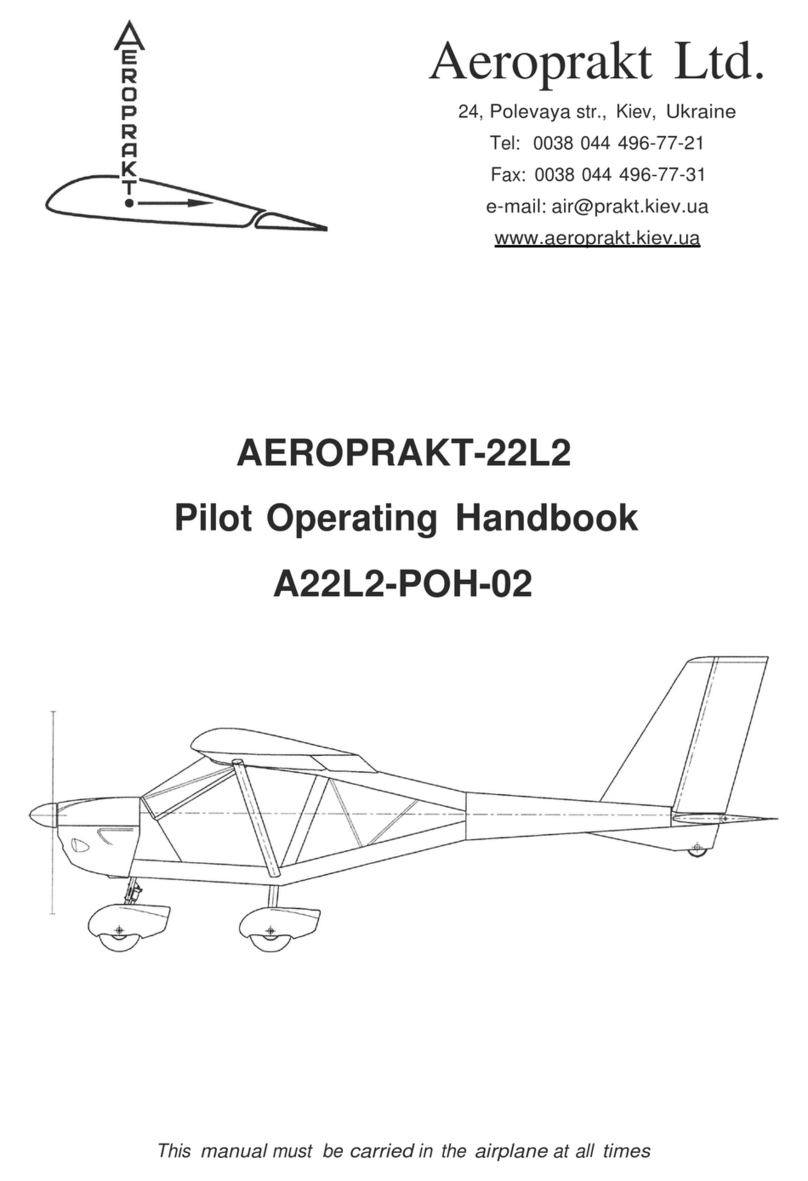
AEROPRAKT
AEROPRAKT AEROPRAKT-22L2 Pilot operating handbook
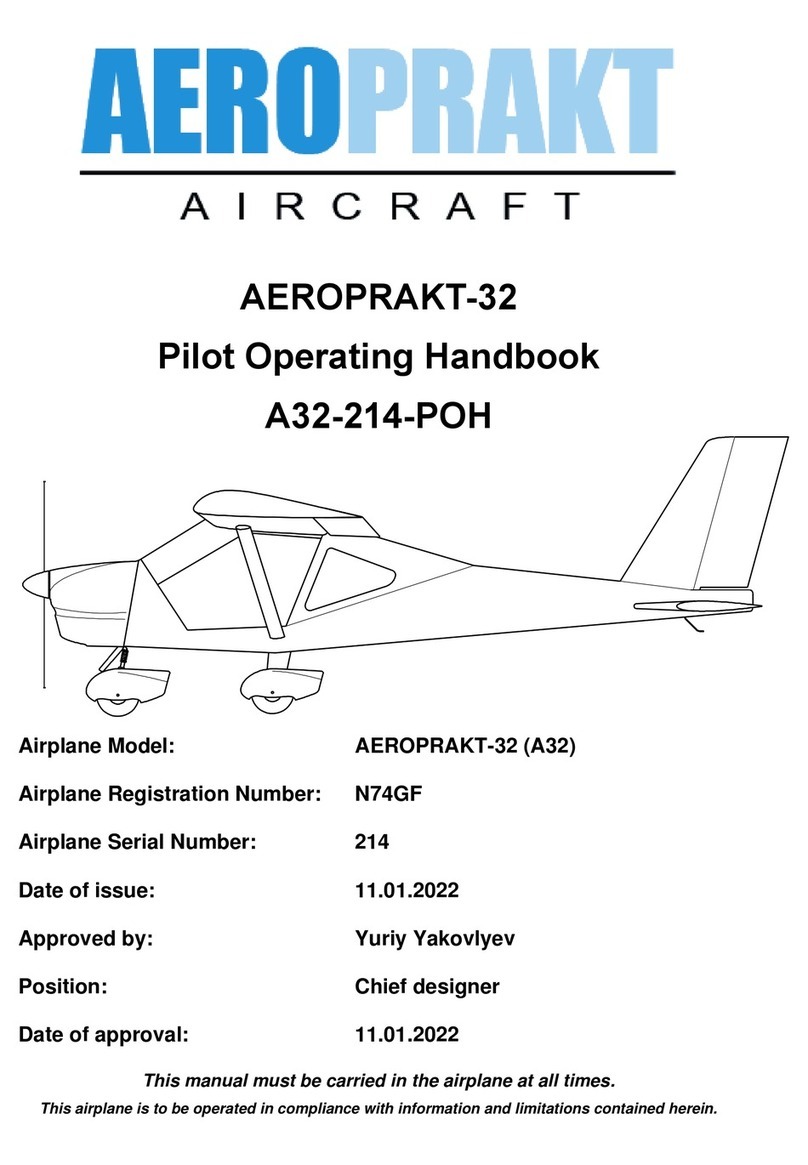
AEROPRAKT
AEROPRAKT A32-214-POH Pilot operating handbook

Advance acoustic
Advance acoustic OMEGA ULS 21 product manual

KANGKE INDUSTRIAL
KANGKE INDUSTRIAL SUPER KRAFT PRO-FLY 540 quick start guide
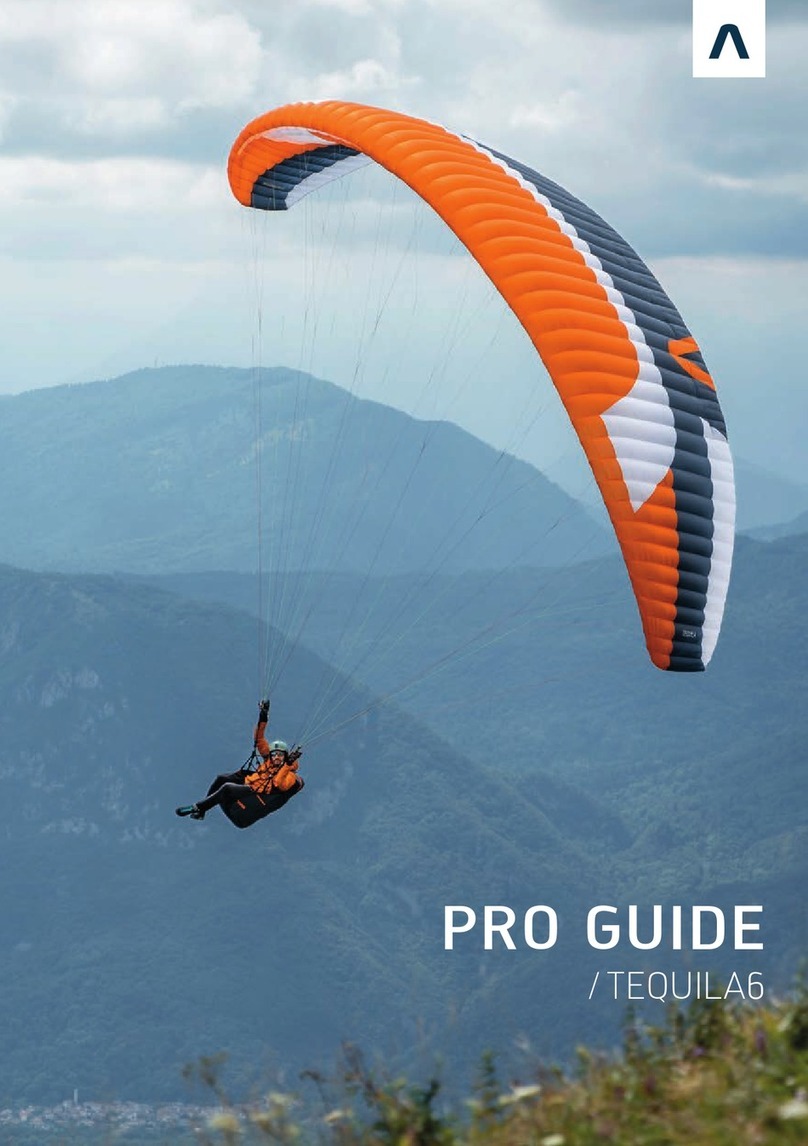
Skywalk
Skywalk TEQUILA6 Pro Guide
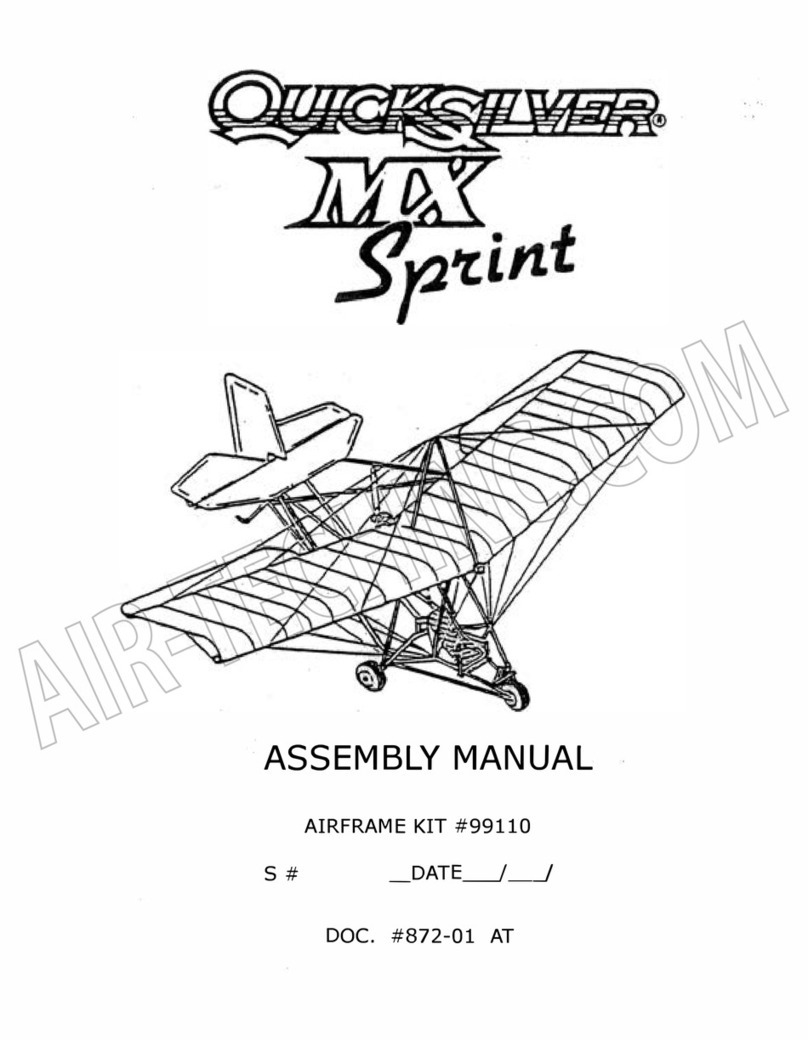
Quicksilver
Quicksilver MAX Sprint Assembly manual

ICP
ICP VENTURA YY-MM-62 Series Pilot operating handbook

Aeros
Aeros PROFI TL Owner's service manual

AEROPRAKT
AEROPRAKT 22LS Pilot operating handbook

Airglas
Airglas GLH3000 Nose Ski Instructions for Continued Airworthiness
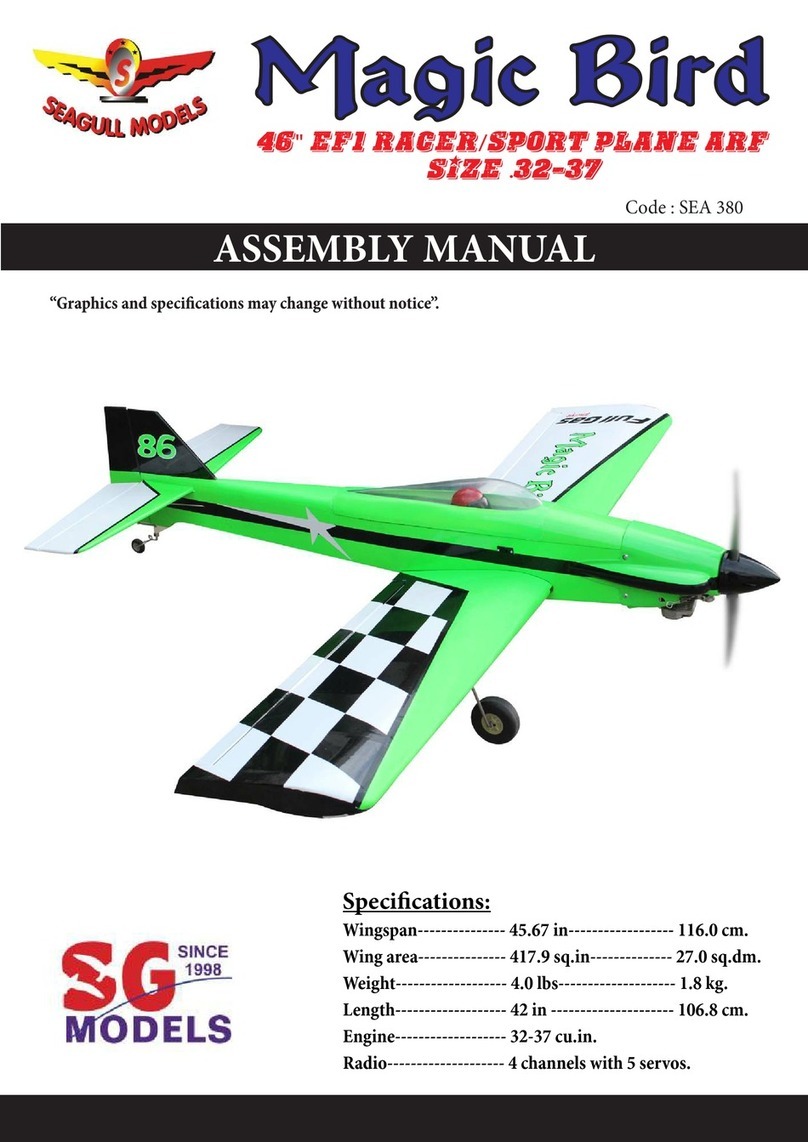
Seagull Models
Seagull Models Magic Bird SEA 380 Assembly manual
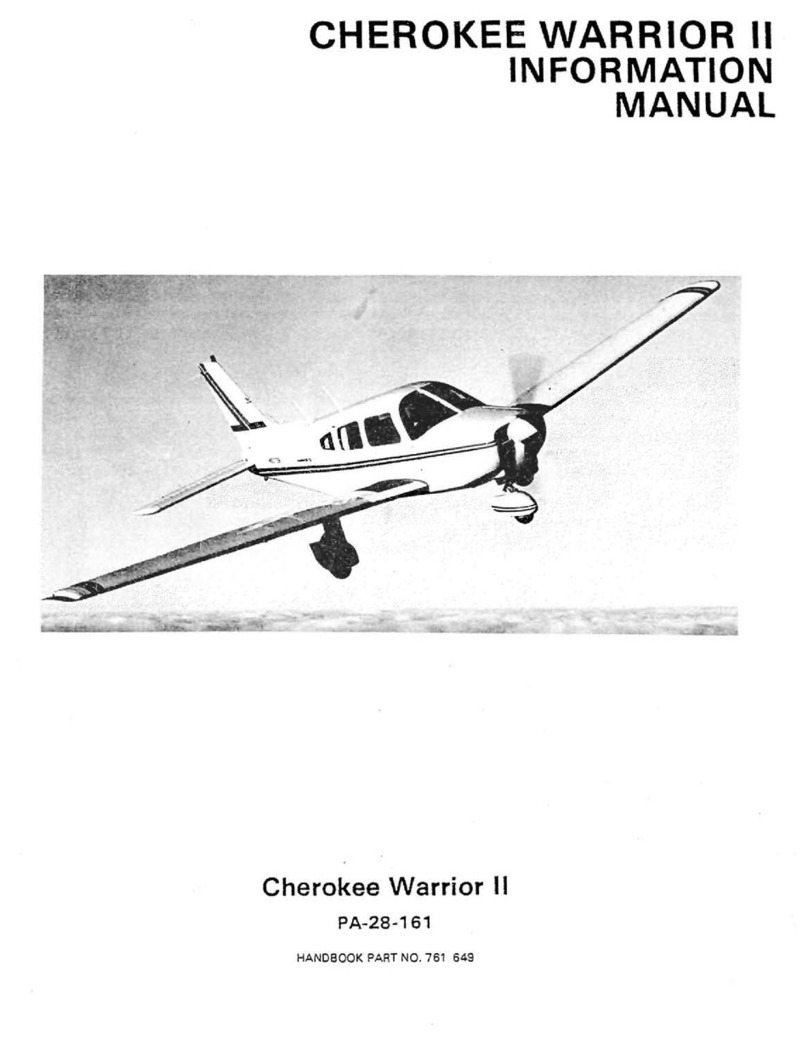
Piper
Piper CHEROKEE WARRIOR II Information manual

